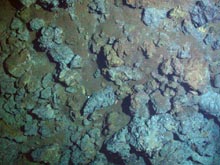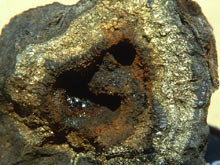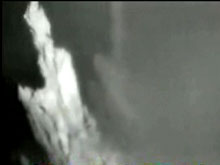
Hydrothermal vents begin to form beneath the seafloor where superheated water flows through cracks in the earth's crust, becoming enriched with dissolved elements from the crust that the water can contain only at extreme temperatures. When it rushes out and mixes with cold seawater, the dissolved elements from the hydrothermal fluid react with elements in the cold seawater, forming new minerals. These minerals precipitate out of the vent fluid and form piles of sediment on the surrounding seafloor, like the mineral sediment in the image above. Click image for larger view and image credit.
Ghosts Of The Deep
January 3, 2006
Kelley Elliott
Web Coordinator
NOAA Office of Ocean Exploration
I sit comfortably on the floor of the DSL control van, my eyes glued to 3 of the 29 monitors in the dark, cool interior. Ghost-like apparitions appear on the screens as the cameras on the Medea camera sled float over a field of extinct hydrothermal vent spires. The structures loom like towers over the seafloor, appearing as tall candles covered with globules of melted wax. Some vents continue to "burn," spewing diffuse smoke that makes the seawater shimmer above the chimneys, and adding an almost mystic aura. The scene continuing to unfold before me is eerily beautiful as one after another, the cathedral-like structures manifest themselves out of the darkness and are revealed by Medea's bright lights.
Perhaps because I am one of the few members of the science team on board who is neither scientist nor technician, the beauty of the deep-sea structures today astound me. I had seen pictures of similar structures before but nothing compared to seeing the spires live, from multiple views provided by the camera sled. The vent field I watch unfold before us in the DSL van, and which we continue to explore today, is the most dense and certainly the tallest field of vent structures we have encountered during the cruise.
The impression led me to wonder about the nature of the spires before me. Were they older than other vent sites we had visited? What are they made of? And how do they form? I inquired to members of the science party for answers to some of my questions.
The vents begin to form beneath the seafloor where superheated water flows through cracks in the earth's crust, acquiring elements from the crust that the water can contain only at extreme temperatures. The superheated water, buoyant and enriched with dissolved elements, rushes up toward the seafloor. Sometimes, if the seafloor surface is extensively permeable, the superheated fluid can mix with cold seawater even before exiting the surface, causing widespread diffuse rather than focused venting, so that vent structures do not form.
Other times, in places where we see hydrothermal vent structures, the superheated fluid is forced through conduits or streams beneath seafloor until it rushes out at a focused point on the seafloor. When it rushes out, the superheated and enriched water mixes with cold seawater. As the superheated fluid mix with and heat up cold seawater, the dissolved elements from the hydrothermal fluid and seawater react and form mineral crystals. These minerals are swept upward into the ocean as black smoke particles, and also construct piles of crystals on the seafloor around the venting fluids.

Over time, the height, width and thickness of a chimney structure builds around the vent flow while the temperature and chemical composition of the hydrothermal fluid varies. Concentric circles of various mineral zones form like tree rings in the chimney wall and evolve with changes in thermal and chemical gradients, as well as changes in chimney wall permeability. The different colors that can be seen in this sliced piece of hydrothermal vent structure reveal some of the different minerals that composed the vent wall. Click image for larger view and image credit.
The superheated hydrothermal fluid continues to rush out, percolating through the crystal piles, and cement the crystals together into a small chimney. Over time, the new chimney continues to grow higher and develops thicker walls that protect the hydrothermal fluid from very rapid chilling and mixing. The decreased chilling of the hydrothermal water in the chimney allows metal-sulfide minerals to precipitate in the chimney center, and dissolves the original anhydrite, forming space in the wall for growth of metal sulfide minerals ("fools gold" pyrite, chalcopyrite, and other minerals rich in iron, copper, zinc, sulfur, and sometimes precious metals). Over time the metal-sulfide content of the chimney increases as hot water percolates outward through the chimney walls, depositing metal-sulfide minerals on the inner chimney wall, and gradually replacing the anhydrite walls with metal-sulfide crystals.
As time passes, the height, width and thickness of the chimney structure that has accreted around the fluid flow continues to grow, and the temperature and chemical composition of the hydrothermal fluid spewing through and out of the vent varies. Concentric circles of minerals form like tree rings in the chimney wall, and adjust their composition to changes in thermal and chemical gradients, and to changes in chimney wall permeability. Many chimneys have hot, copper-rich interior zones, and cooler iron-, zinc - and sulfate- enriched outer zones. The chimney structure continues to grow until the vent fluids stop flowing, or until lava flows cover and destroy the vents.
The process described above provides a general explanation of black smoker chimney growth, however other factors such as biological activity or site-specific differences in fluid composition also affect how the chimney grows in ways that are not yet fully known. Although many things have been learned about how chimneys form, much has yet to be revealed about complexities of their growth.
I peer up at the luminous structures before me, and as the strobe flashes and the still camera takes an image, I see something in the photo I had not noticed before: subtle colors in the globule-like formations on the exterior chimney wall. The vent chimney appears as a dark structure with white calcium sulfate patches on its surfaces, however some sections have more orange in them, and others more reddish-brown. The various colors, I now understand, are the different minerals composing the structure and giving it the eerily beautiful aura.
GalAPAGoS: Where Ridge Meets Hotspot will be sending reports from Dec 3 - Jan 10. Please check back frequently for additional logs from this expedition.
Sign up for the Ocean Explorer E-mail Update List.





























